�
P605tp.indd 1
12/10/09 2:24:41 PM
This page intentionally left blank
This page intentionally left blank
�
Hilary Glasman-Deal
Imperial College London, UK
ICP
Imperial College Press
P605tp.indd 2
12/10/09 2:24:42 PM
�
Published by
Imperial College Press
57 Shelton Street
Covent Garden
London WC2H 9HE
Distributed by
World Scientific Publishing Co. Pte. Ltd.
5 Toh Tuck Link, Singapore 596224
USA office: 27 Warren Street, Suite 401-402, Hackensack, NJ 07601
UK office: 57 Shelton Street, Covent Garden, London WC2H 9HE
Library of Congress Cataloging-in-Publication Data
Glasman-Deal, Hilary.
Science research writing for non-native speakers of English / by Hilary Glasman-Deal.
p. cm.
Includes bibliographical references.
ISBN 978-1-84816-309-6 (alk. paper) -- ISBN 978-1-84816-310-2 (pbk : alk. paper)
1. English language--Technical English--Handbooks, manuals, etc. 2. Technical writing--
Handbooks, manuals, etc. 3. English language--Textbooks for foreign speakers. I. Title.
PE1475.G57 2009
808'.0665--dc22
2009043016
British Library Cataloguing-in-Publication Data
A catalogue record for this book is available from the British Library.
Copyright © 2010 by Imperial College Press
All rights reserved. This book, or parts thereof, may not be reproduced in any form or by any means,
electronic or mechanical, including photocopying, recording or any information storage and retrieval
system now known or to be invented, without written permission from the Publisher.
For photocopying of material in this volume, please pay a copying fee through the Copyright
Clearance Center, Inc., 222 Rosewood Drive, Danvers, MA 01923, USA. In this case permission to
photocopy is not required from the publisher.
Printed in Singapore.
Kim - Science Research Writing.pmd
1
1/13/2010, 1:49 PM
�
FA
v
Introduction: How to Use Th is Book
Th ings should be made as simple as possible, but not any simpler.
— Albert Einstein
Who is this book for?
Th is book is designed to help non-native speakers of English write science
research papers for publication in English. However, it can also be used as a
guide for native English speakers who would like support with their science
writing, and by science students who need to write a Master’s dissertation or
PhD thesis. It is a practical, rather than a theoretical book, and is intended
as a fast do-it-yourself manual for researchers and scientists.
Th e book is aimed at those whose English language ability is at
intermediate level or above. If you have taken an IELTS test, this is
equivalent to a score of above 6.0; if you have taken a TOEFL test then
this is approximately equivalent to a score above 550 (paper-based test) or
91 (iBT). However, if you have managed to read this far without using a
dictionary, you will be able to use this book, even if you don’t understand
every word.
Why do I need it?
Th e goal of scientifi c research is publication, but good scientists are not
always good writers and even native speakers of English sometimes have
diffi culty when they write up their research. Th e aim of this book is to give
you the information, vocabulary and skills you need quickly and easily so
that you can write confi dently using the style and structure you see in the
journals you read.
B875_FM.indd v
B875_FM.indd v
12/11/2009 8:47:52 AM
12/11/2009 8:47:52 AM
�
FA
vi Science Research Writing
As a science researcher, you are able to read and understand complex,
high-level material in your fi eld. However, you may fi nd it diffi cult to
produce written English which is at the same level as your reading. You
may feel that your English writing does not represent the content of your
work eff ectively or accurately. Th e aim of this book is to enable you to use
your reading ability and the material you read to develop the writing skills
your work requires.
Developing the skills to write up your own research is the only way to
join the international science community. If you depend on English speakers
to translate your writing, their translation may not represent exactly what
you intended. If you depend on proofreaders to correct your English they
may not notice some errors, because a sentence which is grammatically
correct is still ‘wrong’ if it does not mean what you intended. Also, a
proofreader may not check whether your writing fi ts the conventional
‘science research’ patterns. For example, you may have forgotten to justify
your choice of method or explain how your results relate to your original
question, and this could mean that an editor of a science journal rejects
your paper as unprofessional.
Writing and publishing a research paper is the best way to get your
career off the ground. If you can turn your thesis or research project into
a useful paper, your CV (Curriculum Vitae) will immediately look more
professional and will be more competitive internationally. You may feel
that you don’t have the time to improve your English, but you already
know most of what you need from the reading you have done over the
years. In order to write up your research for publication you don’t need to
learn much more English than you already know. Science writing is much
easier than it looks.
Most science research is written according to a fairly conventional
structure: fi rst the title, then the abstract, followed by an introduction, aft er
which there is a central section which describes what was done and what
was found and then a discussion and/or conclusion. At the end of the paper
or research article, acknowledgements and references are added. Th is
means that the structure of a research article will be quite similar for all
writers.
Because science writing is so conventional, the amount of grammar
and vocabulary you need to learn is quite small. For example, the non-
technical vocabulary used in scientifi c writing consists of a limited set of
B875_FM.indd vi
B875_FM.indd vi
12/11/2009 8:47:52 AM
12/11/2009 8:47:52 AM
�
FA
Introduction: How to Use This Book vii
words such as attempt, conduct, interpret, evaluate, determine, implement,
formulate, classify, correlate, enhance, which are used as a kind of ‘code’.
All the vocabulary you need to get started (apart from the specialised
vocabulary of your fi eld) is in this book.
What will this book teach me?
Th e book will show you how to discover the conventions of structure,
organisation, grammar and vocabulary in science writing in your fi eld and
will provide you with the tools to write in a similar way and at a similar
level. It will teach you how to turn your research into a paper that can be
submitted to a professional journal. You will also be able to use most of the
information in the book and all of the language and vocabulary if you are
writing a thesis in English.
I have been teaching English for Academic Purposes to science students
for over 30 years. For the past 15 years I have been teaching research writing
in the English Language Support Programme at Imperial College, London,
where I also work closely with individual research students and staff who
are writing a paper or thesis. Th is book is based on the most useful thing
I have learned: when your language skills are not perfect, organising your
information in a conventional way and using conventional language are
very important. If you write according to a conventional model, the reader
knows what you are trying to do because the model you are following is
familiar, and language errors are therefore less signifi cant. A researcher who
begins by writing according to a simple and conventional model will soon
develop higher level skills for writing independently and professionally. Th e
opposite is also true: researchers who do not begin by writing according to
a conventional model are less likely to develop these skills.
How does the book work?
Th e strategy in this book can be summed up as follows: carefully examine
good examples of the kind of writing you would like to produce, identify
and master the structure, grammar and vocabulary you see in these
examples and then apply them in your own writing.
Th e book is divided into fi ve units, each dealing with one section of a
research article. Unit 1 deals with the Introduction, Unit 2 the Methodology,
Unit 3 the Results, Unit 4 the Discussion or Conclusion and Unit 5 the
B875_FM.indd vii
B875_FM.indd vii
12/11/2009 8:47:52 AM
12/11/2009 8:47:52 AM
�
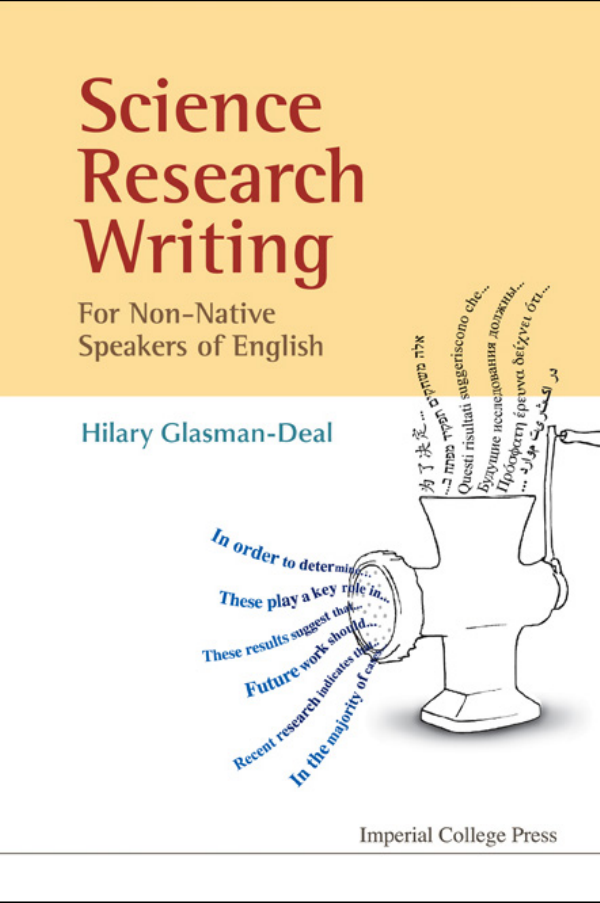
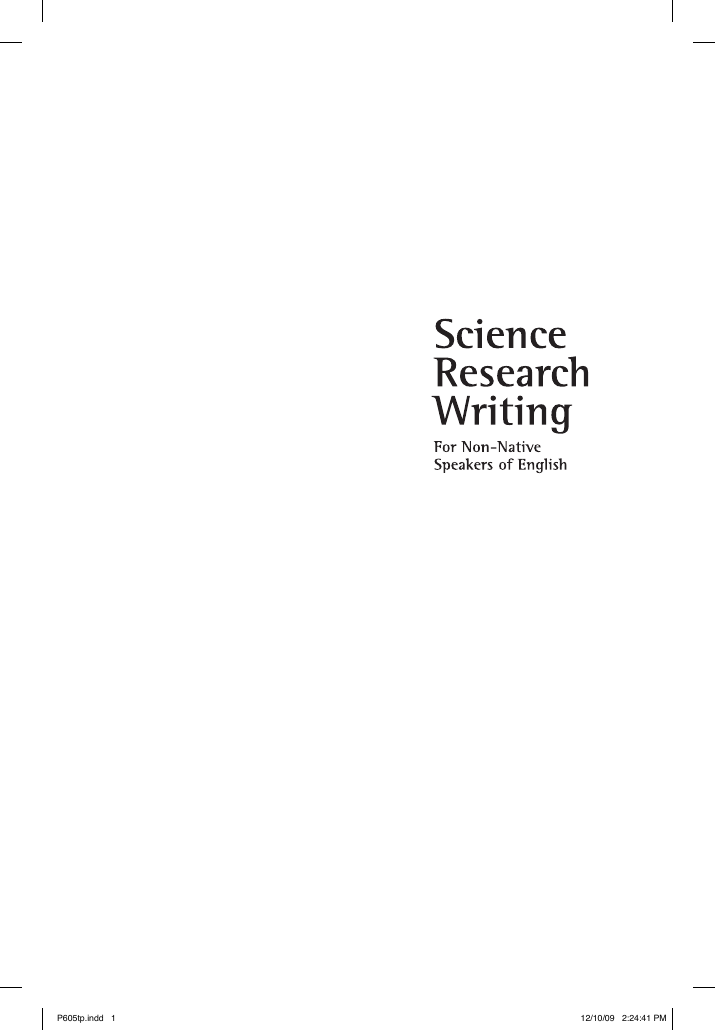

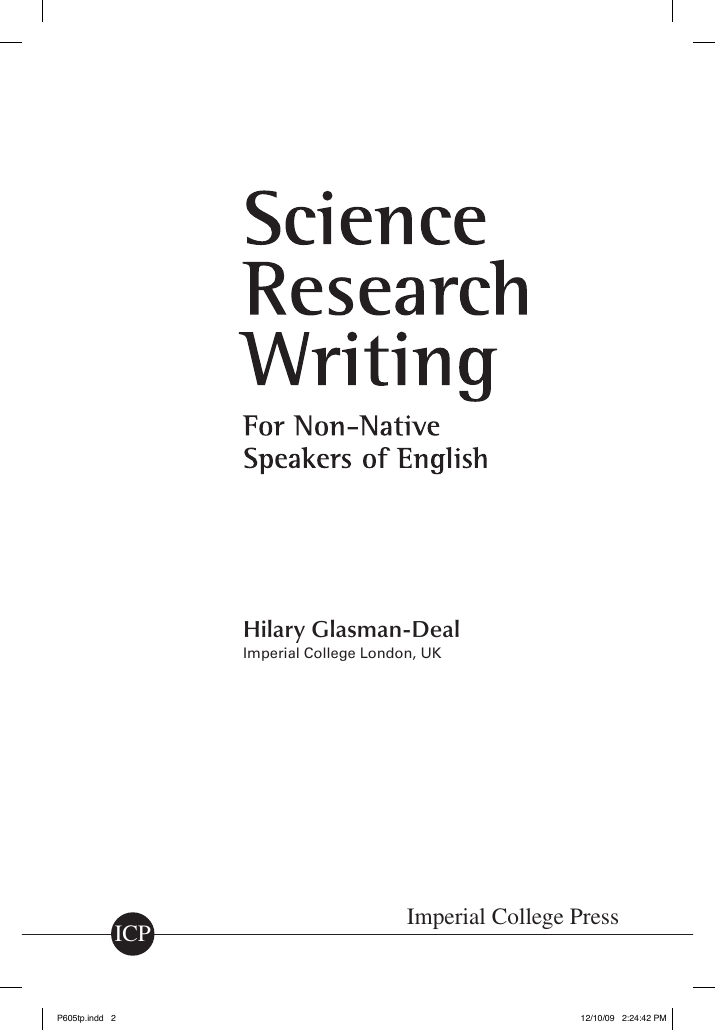
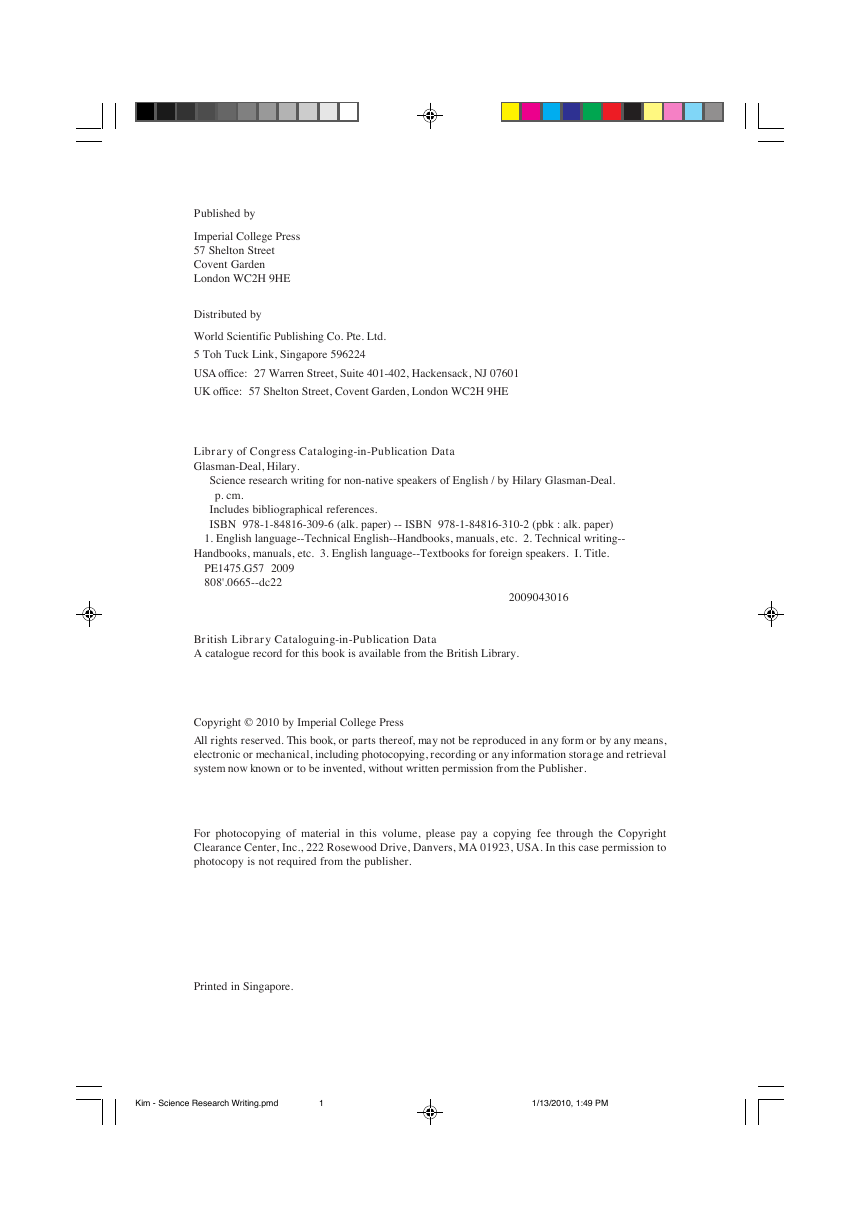
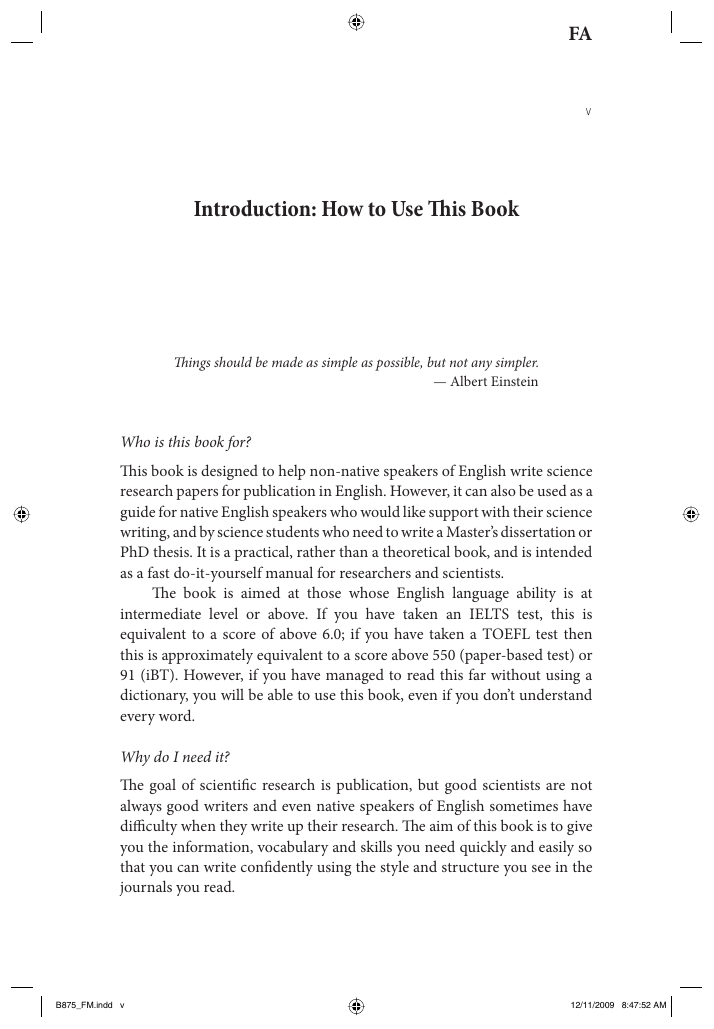
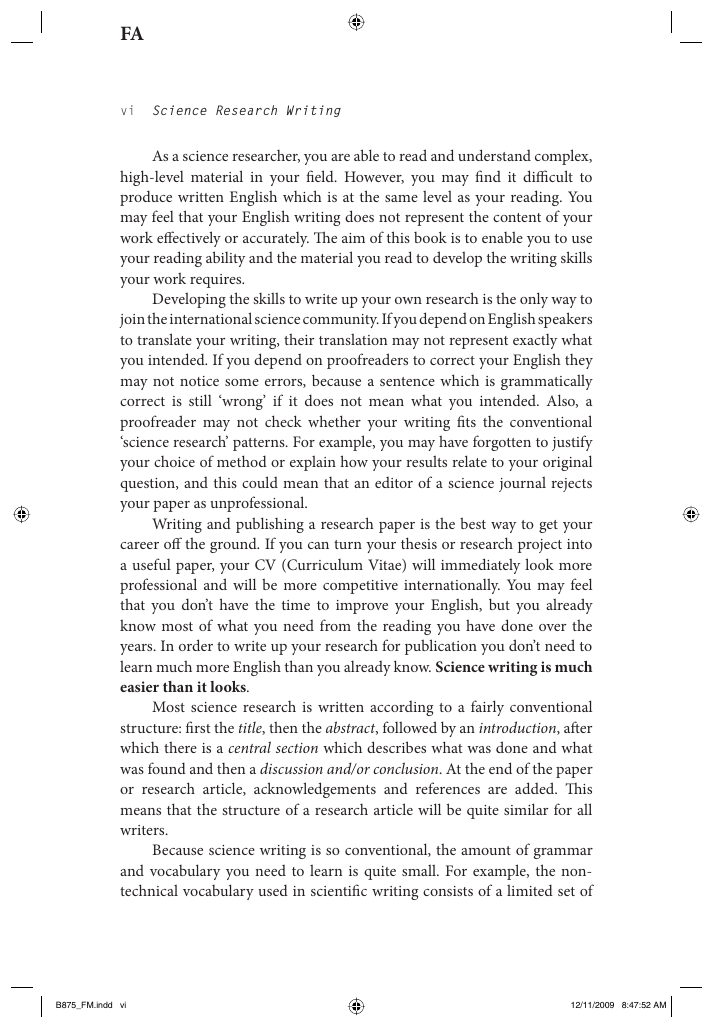
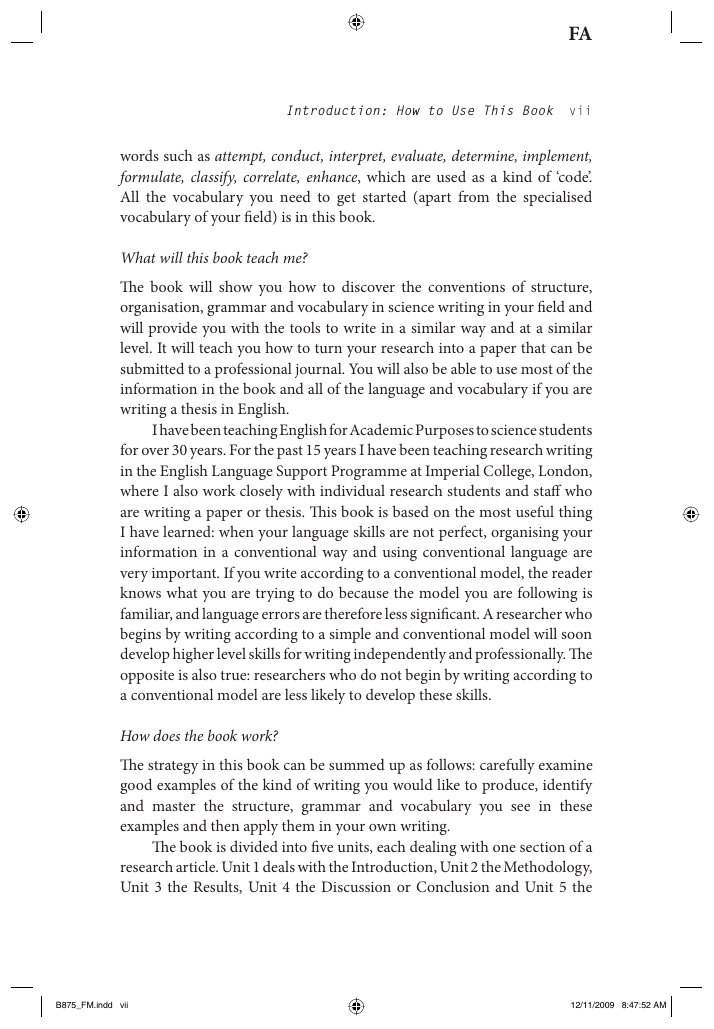








 2023年江西萍乡中考道德与法治真题及答案.doc
2023年江西萍乡中考道德与法治真题及答案.doc 2012年重庆南川中考生物真题及答案.doc
2012年重庆南川中考生物真题及答案.doc 2013年江西师范大学地理学综合及文艺理论基础考研真题.doc
2013年江西师范大学地理学综合及文艺理论基础考研真题.doc 2020年四川甘孜小升初语文真题及答案I卷.doc
2020年四川甘孜小升初语文真题及答案I卷.doc 2020年注册岩土工程师专业基础考试真题及答案.doc
2020年注册岩土工程师专业基础考试真题及答案.doc 2023-2024学年福建省厦门市九年级上学期数学月考试题及答案.doc
2023-2024学年福建省厦门市九年级上学期数学月考试题及答案.doc 2021-2022学年辽宁省沈阳市大东区九年级上学期语文期末试题及答案.doc
2021-2022学年辽宁省沈阳市大东区九年级上学期语文期末试题及答案.doc 2022-2023学年北京东城区初三第一学期物理期末试卷及答案.doc
2022-2023学年北京东城区初三第一学期物理期末试卷及答案.doc 2018上半年江西教师资格初中地理学科知识与教学能力真题及答案.doc
2018上半年江西教师资格初中地理学科知识与教学能力真题及答案.doc 2012年河北国家公务员申论考试真题及答案-省级.doc
2012年河北国家公务员申论考试真题及答案-省级.doc 2020-2021学年江苏省扬州市江都区邵樊片九年级上学期数学第一次质量检测试题及答案.doc
2020-2021学年江苏省扬州市江都区邵樊片九年级上学期数学第一次质量检测试题及答案.doc 2022下半年黑龙江教师资格证中学综合素质真题及答案.doc
2022下半年黑龙江教师资格证中学综合素质真题及答案.doc